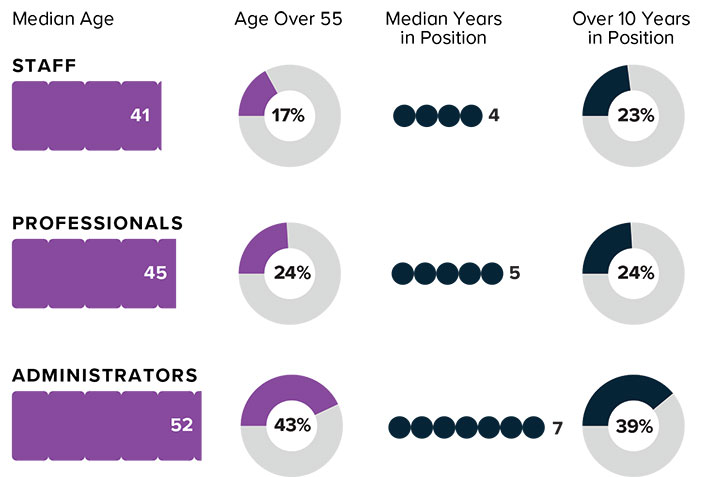Around 43% of IT administrators in higher education are over 55 years old, and 39% of IT administrators have been in their current role for more than 10 years. The time to begin succession planning is now.

The following is an excerpt from Adam Pritchard, Keith McIntosh, and Jasper McChesney, Diversity in Higher Education Information Technology: From Today's Workforce to Tomorrow's Leaders, CUPA-HR Research Report (Knoxville, TN: College and University Professional Association for Human Resources, July 2019).
An important concern for many U.S. employers is the expected wave of retirements in leadership positions as the last of the baby boomers (born between 1946 and 1964) turns 55 years old in 2019, with many already at or past the expected retirement age. Administrators in higher education IT are no exception. For higher ed IT, this demographic transition may present an opportunity to make progress on diversity as this less-diverse generation gives way to a younger, more diverse generation.1
Long-Serving Administrative Leadership
The median age of the IT administrators highlighted in this report is 52 years old; however, the proportion of higher education IT employees that are older suggests that higher education IT may soon face succession planning challenges. Around 43% of IT administrators are over 55 years old (see figure 1). The median years in position is seven, but almost 39% of higher education IT administrators have more than 10 years in their current role. This is high compared to all administrators in higher education, where the median time in position is five years, and only 25% of administrators have more than 10 years in their current positions.

Diversity in the Pipeline
Certain IT positions are considered part of the pipeline to administrative leadership roles. Figure 2 highlights key demographics for eight such positions from the CUPA-HR Professionals in Higher Education Survey. Some of these positions have higher representation than average for women or individuals from certain racial/ethnic groups, and therefore may provide opportunities to recruit diverse future leaders as older employees near retirement. Some in higher education IT have argued that to close the gap on diversity in the field, a different way of thinking about recruitment, retention, and creating inclusive environments may be necessary, including deliberate efforts to use this type of data to recruit more diverse leaders.2 Higher education IT may also need to consider recruiting diverse candidates for leadership roles from outside of higher education or from positions not typically identified as part of traditional job progressions.

In Summary
Around 43% of IT administrators in higher education are over 55 years old, and 39% of IT administrators have been in their current role for more than 10 years. The time to begin succession planning is now—and the data show that certain positions in the immediate higher education IT pipeline may present opportunities to improve DEI in the process.
Notes
- U.S. Census Bureau, "Millennials Outnumber Baby Boomers and Are Far More Diverse, Census Bureau Reports," press release, June 25, 2015. ↩
- Keith W. McIntosh, Jeffrey Pomerantz, Helena Rodrigues, Craig Smith, and Melissa Woo, "Expanding Your Recruitment Pool through Increasing Diversity, Equity, and Inclusion," EDUCAUSE Review, June 5, 2017. ↩
Adam Pritchard is Senior Survey Researcher at CUPA-HR.
Keith McIntosh is Vice President and Chief Information Officer at the University of Richmond.
Jasper McChesney, former Data Visualization Researcher at CUPA-HR, is Senior Data Analyst at the College of Information and Computer Sciences at the University of Massachusetts Amherst.
© 2019 CUPA-HR
EDUCAUSE Review 54, no. 4 (Fall 2019)
